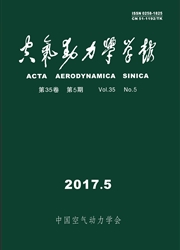

 中文摘要:
中文摘要:
通过分析空腔底面中心线上声压级分布与不同测点声压频谱特性,着重研究了高亚声速空腔绕流的气动噪声特性。空腔模型长深比分别为6、10和15,自由来流马赫数为0.8,基于每米的雷诺数为1.55×107,测量的空腔前缘的边界层厚度为0.034m。结果表明:空腔后缘处于噪声产生区,声压级较高;闭式和过渡式空腔因深度较小,来流剪切层触及了空腔底面,干扰了从腔后壁向腔前壁的噪声反馈回路,限制了腔内流动自激振荡的形成;开式空腔深度较大,剪切层直接跨过空腔中部、撞击腔后壁,并产生强烈噪声,噪声从腔后壁通过空腔向前壁的反馈回路未受到干扰,故腔内流动出现自激振荡和多个声压峰值频率。
 英文摘要:
英文摘要:
Aerodynamic noise characteristics of cavity flow at high subsonic speeds are investigated based on analysis of sound pressure level distributions on the cavity floor centerline and sound pressure frequency spectrum characteristics at different measurement positions.The cavity studied was with the length-to-depth ratios of 6,10 and 15.The test was performed over a Mach number of 0.8 at a Reynolds number of 1.15×107 per meter with a boundary-layer thickness of approximately 0.034m.The results indicate that SPL in the region upstream of the cavity rear-face is more than that in the region downstream of the cavity forward-face.Impingement of the shear-layer and the cavity floor disturbs the noise feedback mechanism from the cavity rear-face to forward-face for closed and transitional cavity,which causes an incurrence of self-sustained flow oscillations and peak frequencies of sound pressure.However,the shear-layer bridges open-cavity,which has no influence on the mechanism.The self-sustained flow oscillations and some peak frequencies of sound pressure occur inside the open cavity.
 同期刊论文项目
同期刊论文项目
 同项目期刊论文
同项目期刊论文
 期刊信息
期刊信息
